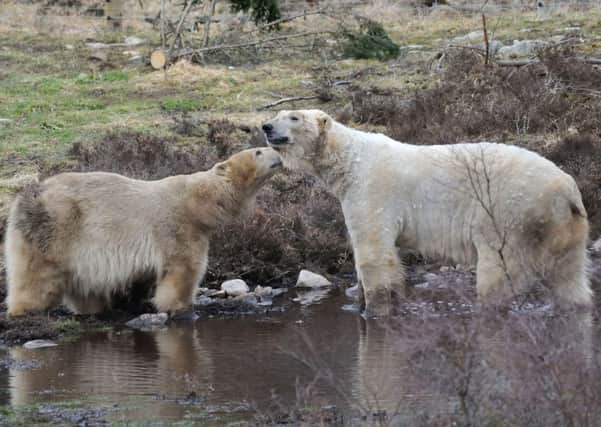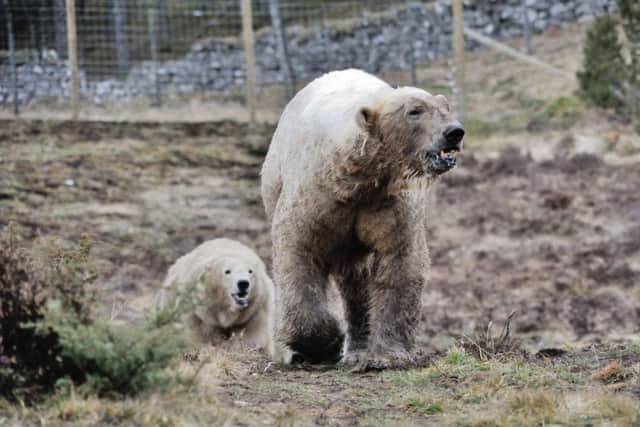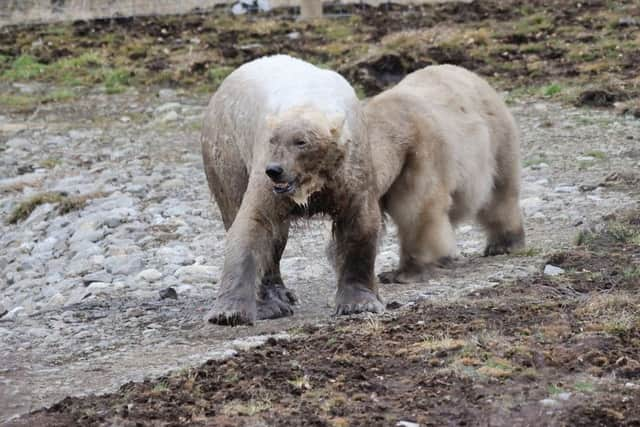Hopes high for cubs as polar bears begin breeding in the Highlands


There is high optimism that tiny cubs will be born at the Scottish centre now that one of the resident males, Arktos, was successfully introduced to Victoria, who arrived last year.
Last Tuesday, Arktos, the oldest of the park’s two male polar bears, was transported the short mile across the Kingussie centre to move into a specially designed enclosure next to Victoria, the UK’s only female polar bear.
Advertisement
Hide AdAdvertisement
Hide AdKeepers were delighted to see the bears take to each other straight away, with lots of head bobbing, bouncing and vocalisations.


The new pair were so keen on each other that they slept at the fence line and repeatedly tried to touch.
On Saturday, the two bears met properly for the first time as Arktos went to live temporarily in Victoria’s enclosure.
Mating has since occurred on many occasions and Arktos and Victoria will continue to live together 24 hours a day for the next week or two, mimicking what would occur naturally in the wild. Sleeping side by side, following each other around and resting their heads on each other, the two polar bears have really bonded.
Vickie Larkin, head carnivore keeper at RZSS Highland Wildlife Park, said: “It’s fantastic news and their introduction couldn’t have gone any better.


“Both polar bears have really warmed to each other and all the signs are really positive. From the first moment they met, Arktos has been really gentle with Victoria and their bond has been immediate.
“Polar bear breeding is inherently complex as the species are induced ovulators, meaning that the female only releases an egg after initial mating occurs.
“They also practice delayed implantation, where the egg doesn’t implant into the uterine wall until some months later.
Advertisement
Hide AdAdvertisement
Hide Ad“If successful, Victoria will not fall pregnant until August to September time. Other key stages are her entering the birthing den in October to November and potentially giving birth in December to January. Any cubs would then not come out of the birthing den until March to April 2017.”


Chris West, CEO of the Royal Zoological Society of Scotland, said: “Listed as Vulnerable on the IUCN Red List of endangered species, this is the first time in 25 years that polar bear breeding has successfully taken place on UK soil. This is something to be celebrated.
“At RZSS we have a duty to help protect the future of this magnificent species, and our polar bears benefit from the largest enclosures in the world and expert husbandry that is second to none.
“Climate change is predicted to cause further sea-ice losses and horrifying statistics estimate that the global population of polar bears could decline by over 30% in just three generations.
“Any cubs born to Victoria will help to populate a healthy ex-situ ‘ark’ of polar bears to give conservationists as many future options as possible.


“As we always say, in an ideal world, conservation would happen primarily in the wild but, when issues exist in the wild, the next best thing is a combined in-situ and ex-situ approach that has the goal of one day restoring or augmenting wild populations.”
RZSS Highland Wildlife Park is home to three polar bears: Victoria, Arktos and Walker.
Arktos was chosen to breed with Victoria as he is older and a genetically more important male and Walker’s genes are already well represented within the captive population.
Advertisement
Hide AdAdvertisement
Hide AdVictoria arrived at the park in March last year from Aalborg Zoo in Denmark. She was born on 12 December 1996 at Rostock Zoo in Germany.
Arktos arrived at the Park on 4 April 2012 from Hanover Zoo in Germany. He was born on 30 November 2008.
Victoria gave birth in 2008. Milak, her first cub, became an online sensation when hundreds of thousands of people from 75 countries around the world followed the early days of the cub’s life whilst still in the maternity den.
It was one of the first times that webcams were able to show what life is like with a mother and a new-born cub. In December 2014, at natural dispersal age, Milak was transported to Zoo Saint-Félicien in Quebec as part of an exchange to augment the Canadian captive polar bear programme.
Funnily enough there was confusion over Milak’s sex; at first the cub was understood to be male, but then was later revealed to be a female.
Arktos and Walker have been firm friends ever since they met in April 2012 and like to spend their time chasing, wrestling, swimming and eating together. They are both very playful.
The two bears are trained by keepers to allow simple health and weight checks without the need for anaesthesia.
Arktos and Walker are the only two male polar bears on public display in Scotland and share a custom built enclosure that is one of the world’s largest and best polar bear enclosures at almost six acres in size.
Advertisement
Hide AdAdvertisement
Hide AdVictoria has her very own large custom-built enclosure, which features a pond and soft areas of ground, as well as plenty of space for her to explore.
In total, the park devotes more space to polar bears (over 10 acres) than any other zoological institution in the world.
Victoria’s enclosure is completely separate to male polar bears Walker and Arktos, who have a large bachelor enclosure at the other side of the Park. This allows the park keepers to mimic the behaviour of polar bears in the wild who only come together to mate.
Polar bears are solitary in the wild, actively seeking out mating partners in breeding season.
Female polar bears reach sexual maturity between the ages of four to six years, whilst males will typically reach maturity at six years of age, but will typically only mate when they are between eight and ten years old.
Mating normally occurs from March to June on the ice, but for most of the bears it will occur during April and May.
In the wild, male polar bears will track females’ scent until they find a mate. Once this occurs, they will usually have to fight other male opponents for the chance to mate.
Female polar bears will normally only reproduce once every three years, whereas the males will often mate with a few different females every breeding season.
Advertisement
Hide AdAdvertisement
Hide AdPolar bear cubs will stay with their mother in the den until March or April. If Victoria has cubs, this is likely when her cubs will come out of the den for the first time.
New-born polar bears are born blind, covered with short, soft hair and are entirely dependent on their mothers.
Whilst in the den, the cubs will feed on a fat-rich milk from their mother, causing them grow rapidly so that by the time they leave the den in March to April they can weigh between 10-12kg. The milk contains about 31% fat.
Polar bear cubs will open their eyes after the first month.
When the cubs first leave the den after three to four months they will initially spend the first two weeks close to the den entrance, allowing them to acclimatise to the weather and to walking.
Cubs will nurse for at least 20 months, but will also start eating food at about three to four months of age. Cubs will learn to hunt by watching their mother.
Cubs will remain with their mothers for just over two years, in which time they will learn how to hunt and survive.
